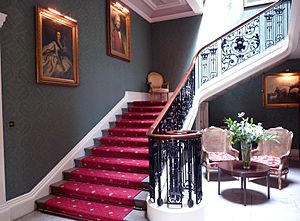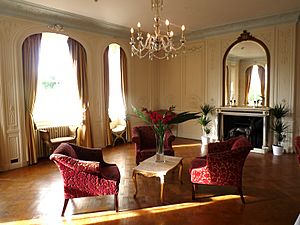Addington Palace facts for kids
Addington Palace is a large, beautiful house built in the 1700s. It is located in Addington, near Croydon in south London, which is part of the historic county of Surrey. This grand building was constructed where an older house from the 1500s once stood.
Addington Palace is famous for being the summer home of the Archbishop of Canterbury from 1807 to 1897. The Archbishop is the main leader of the Church of England. Later, from 1953 to 1996, the Royal School of Church Music used the palace. Today, Addington Palace is a popular place for meetings, weddings, and a country club. Its large grounds are now home to a golf course.
Contents
The Story of Addington Palace
Early Beginnings and Traditions
The first house on this land was called Addington Place. It was built around the 1500s. A very old and special tradition was linked to the owners of Addington. They would make a spiced chicken porridge called Malepigernout (or Dillegrout). This dish was served to the King or Queen of England during their Coronation ceremony.
The Leigh family owned the Addington estate for a long time. They gained this special duty before King Charles II was crowned in 1661. The Leigh family owned the estate until the early 1700s.
A New Owner and a Grand New House
Sir John Leigh passed away in 1737 without children. His estate went to distant relatives. They eventually sold the property to a man named Barlow Trecothick. Barlow Trecothick grew up in Boston, Massachusetts, and became a successful merchant. He later moved to London and continued his trading business.
Barlow Trecothick also became a Member of Parliament for the City of London from 1768 to 1774. He even served as the Lord Mayor of London in 1770. He bought the Addington estate for £38,500.
Trecothick decided to build a brand new house. It was designed by Robert Mylne in the Palladian style. This style is known for its grand, balanced look. The new house was a country mansion with single-story wings. Sadly, Barlow Trecothick died in 1774 before the house was finished.
His heir, James Ivers, inherited the estate. James had to change his last name to Trecothick to receive the property. He continued the work on the house. He also hired Lancelot "Capability" Brown, a famous landscape designer, to create the beautiful grounds and gardens.
From Private Home to Archbishop's Residence
Due to money problems, James Trecothick had to sell the estate in 1802. The property was sold in parts in 1803. The next owners also faced financial difficulties. In 1807, an Act of Parliament allowed the mansion to be sold again.
This sale was important because the nearby Croydon Palace, which was the Archbishop of Canterbury's home, had become old and difficult to use. So, Addington Palace was bought for the Archbishops of Canterbury. At first, it was called Addington Farm, but over time, it became known as Addington Palace. The archbishops made more changes and made the building even bigger. Richard Norman Shaw, a well-known architect, oversaw some of this work.
Addington Palace became the official summer home for six Archbishops:
- Charles Manners-Sutton (Archbishop from 1805–1828)
- William Howley (Archbishop from 1828–1848)
- John Bird Sumner (Archbishop from 1848–1862)
- Charles Thomas Longley (Archbishop from 1862–1868)
- Archibald Campbell Tait (Archbishop from 1868–1882)
- Edward White Benson (Archbishop from 1883–1896)
Most of these Archbishops are buried at St Mary's Church in Addington. Edward White Benson is buried in Canterbury Cathedral.
Later Owners and Wartime Use
In 1897, the house was sold to Frederick Alexander English. He was a diamond merchant from South Africa. After he passed away, the mansion was used by the Red Cross during the First World War. It became a hospital for people with fevers. Finally, in 1930, the building was taken over by the County Borough of Croydon.
Addington Palace Today
A Historic Building with New Life
Addington Palace was given a special status in 1951. It was listed as a Grade II* building. This means it is a very important historic building.
In 1953, the Royal School of Church Music leased the palace. They first used it to house choirboys from all over Britain. These boys were brought together to sing at the Coronation of Queen Elizabeth II. The building was home to the school's music publishing, its college, and its choir school until 1996.
After 1996, a private company took over Addington Palace. They developed it into a place for conferences and banquets. It also became a health club and country club. Today, it is a very popular place for weddings.
Gardens and Surroundings
Addington Palace is surrounded by a beautiful park and golf courses. Its gardens still mostly follow their original design. Many parts of the grounds have been leased by golf clubs. A special housing area called Bishops Walk was built on a private road nearby.
A very large and old Cedar of Lebanon tree stands next to the Palace. It is considered one of the Great Trees of London.






